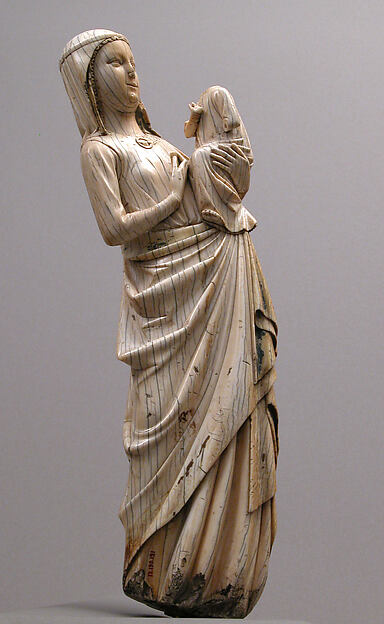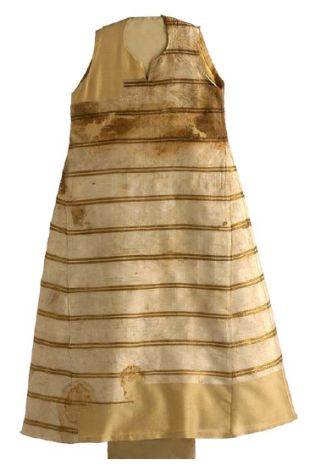My very first completely hand-sewn piece of garb (aside from accessories) is finally finished:
 |
| Where would I be without bathroom mirror selfies??? |
Rationale:
Wearing "just a dress" isn't really wearing historical clothing (someday, I swear, there's going to be a whole post on this featuring guest appearances by my favorite yellow tunic and every possible accessory / clothing layer I can find to demonstrate my point). To really make it work, you need more layers -- put something under that dress, and something else over it, and put something on your feet, and some more things on your head! This project was born out of this philosophy: I needed another layer.
A sleeveless dress, which I call a cyclas or a surcote/surcotte [literally "over the cote" so could be used for any garment that is worn as an outer layer with a gown/tunic/cote] since I haven't found one single standard term for this garment, appeared in the 13th century and presumably evolved into the later sideless surcote (in fact, I think you can trace this evolution when you examine early- to mid-14th century manuscripts like the Taymouth Hours and the Luttrell Psalter). It seems that there was both a male version and a female version, with the male version typically being shorter and split up the front and the female version typically reaching to or past the feet and not being split. For women, the cyclas was worn over the gown and under a mantle (if a mantle was worn) and could be either plain or decorated. I have not examined enough images to be able to confidently state a particular age or social standing with which this garment was predominately associated.
Medieval Images:
Here are some representative images of women wearing cyclas-like-things in 13th/14th c. English and French artwork:
 |
| Virgin with child, Northern France, 1250-1275, ivory (trace evidence suggests it may have originally been painted and gilded). In the Metropolitan Museum of Art collection. Click the link for multiple views and more information. |
 |
| End of the 13th century, France; Lausanne, Bibliothèque Cantonale et Universitaire, U 964 - Biblia Porta; fol.178r. There is a facsimile online here. |
 |
| The Ormesby Psalter (Bodleian Library MS. Douce 366), ca. 1310 (England). |
 |
| Ibid. Both of these were found at this blog. |
 |
| DeBrailes Hours, f. 24r; I'll admit I might be stretching a little with this one, but it's the earliest specifically English image of a surcote/cyclas I could find. |
 |
| The lady appears to be wearing a cyclas that buttons in the front. |
Archeological Garments:
There are a couple of extant garments which appear to have been something at least broadly similar to the cyclas as I am trying to recreate it. For example, this tunic from Rønberg Mose:
 |
| I. Marc Carlson; source: http://www.personal.utulsa.edu/~marc-carlson/cloth/ronberg.html |
This is an extant silk surcotte from 1307 that apparently belonged to King Rudolf I of Bohemia:
 |
| Source: http://www.kostym.cz/Anglicky/6_Dobove/07_Svrchniky/VI_07_08.htm (includes original source for above image / information about this garment) |
 |
| Source: http://www.kostym.cz/Anglicky/1_Originaly/01_Goticke/I_01_61.htm |
 |
| I. Marc Carlson, source: http://www.personal.utulsa.edu/~marc-carlson/cloth/birgitta.html |
What I Did:
I had some fairly lightweight green wool fabric that I wanted to use for this project. I cut two body pieces roughly the width of my shoulder to shoulder measurement, then used what remained of the fabric to make gores. I used the width of the fabric for the length of each piece. I laid out my pieces and free-handed an arm shape similar to that from the Rønberg Mose garment -- my gores came all the way to the top of my shoulder piece.
At this point, I used running stitch to sew the pieces together. I tried it on... and it was too small. I mean, it fit, technically, it was just a very "sexy" fit. Not right for 13th century clothes. Shoot. That's the disadvantage of winging it on gore size, I guess. The wool was from the thrift store, so no chance of getting more. I went through my fabric stash and found a piece of a similar weight fabric in a pale gold color. This seemed like my best option for making this work, so I used it to cut out some more gores. I ripped out the seams and added the gores, adjusted the armscye to accommodate the new additions, and sewed everything together again using running stitch. I finished the seams using hem stitch. (Folding the raw edges under first.)
This was my first completely hand-sewn garment (other than hosen and hats), I normally do my joining seams by machine and then hand-finish them. This was a nice step up for me, and I actually enjoyed the process. I use linen thread for all my hand sewing, which was, according to Crowfoot et al, typical. I still have not found a single perfect answer to whether or not the linen thread I use should match the fabric. While I have always heard that linen was difficult to dye historically, I also remember reading (also in Crowfoot et al?) that royal household records mention purchasing dyed linen thread for sewing.
For someone of lower means, I do not think that dyed linen would have been the most likely option, though, even if it was available. Wool thread, possibly, including threads pulled from the fabric itself, would be reasonable, or undyed (and probably unbleached) linen thread. I had a spool of white linen thread on hand which I decided to go ahead and use -- even the clothing fragments found in the London finds (again, see Crowfoot et al) had been sewn together with linen thread (which had rotted away when the wool remained), suggesting that even ordinary persons used linen thread instead of wool.
I finished the neck and arms using a narrow bias-cut strip of linen with the edges folded under and a line of running stitch on each edge. This matches a finishing technique on an extant garment (from the late 14th century IIRC) shown in Crowfoot et al and is my preferred method. Here are some photos of the process and end result (this is the inside of the garment):
 | ||
| Pinning is your friend. This also lets you see what my seams looked like. |
To do the hem, I simply measured a curve from the shoulder, marked it and cut it:
I started off doing the hem with a hem stitch (ha ha) but I didn't like how the fabric was lying, so I ended up just using running stitch. I double-folded the hem.
Final Thoughts
I'm very pleased with how this turned out. Doing all of the sewing by hand was a good learning experience for me, and a really big leap forward in my abilities and confidence. I'm looking forward to wearing this for Twelfth Night coronation next weekend, and at many future events.







View comments